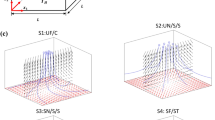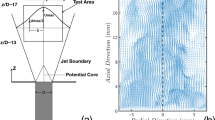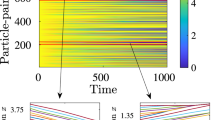Abstract
Several theories1,2,3,4,5 predict that a limiting and universal turbulent regime — ‘ultrahard’ turbulence — should occur at large Rayleigh numbers (Ra, the ratio between thermal driving and viscous dissipative forces) in Rayleigh–Bénard thermal convection in a closed, rigid-walled cell. In this regime, viscosity becomes negligible, gravitationally driven buoyant plumes transport the heat and the thermal boundary layer, where the temperature profile is linear, controls the rate of thermal transport. The ultrahard state is predicted to support more efficient thermal transport than ‘hard’ (fully developed) turbulence: transport efficiency in the ultrahard state grows as Ra1/2, as opposed to Ra2/7 in the hard state6. The detection of a transition to the ultrahard state has been claimed in recent experiments using mercury7 and gaseous helium8. Here we report experiments on Rayleigh–Bénard convection in mercury at high effective Rayleigh numbers, in which we see no evidence of a transition to an ultrahard state. Our results suggest that the limiting state of thermal turbulence at high Rayleigh numbers is ordinary hard turbulence.
This is a preview of subscription content, access via your institution
Access options
Subscribe to this journal
Receive 51 print issues and online access
$199.00 per year
only $3.90 per issue
Buy this article
- Purchase on Springer Link
- Instant access to full article PDF
Prices may be subject to local taxes which are calculated during checkout



Similar content being viewed by others
References
Shraiman, B. I. & Siggia, E. D. Heat transport in high-Rayleigh-number convection. Phys. Rev. A 42, 3650–3653 (1990).
Siggia, E. D. High Rayleigh number convection. Annu. Rev. Fluid Mech. 26, 137–168 (1994).
Kraichnan, R. H. Turbulent thermal convection at arbitrary Prandtl number. Phys. Fluids 5, 1374–1389 (1962).
Howard, L. N. Bounds on flow quantities. Annu. Rev. Fluid Mech. 4, 473–494 (1972).
Busse, F. H. The optimum theory of turbulence. Adv. Appl. Mech. 18, 77–121 (1978).
Castaing, B. et al. Scaling of hard thermal turbulence in Rayleigh-Bénard convection. J. Fluid Mech. 204, 1–30 (1989).
Cioni, S., Ciliberto, S. & Sommeria, J. Strongly turbulent Rayleigh–Bénard convection in mercury: comparison with results at moderate Prandtl number. J. Fluid Mech. 335, 111–140 (1997).
Chavanne, X. et al. Observation of the ultimate regime in Rayleigh–Bénard convection. Phys. Rev. Lett. 79, 3648–3651 (1997).
Belmonte, A., Tilgner, A. & Libchaber, A. Temperature and velocity boundary layers in turbulent convection. Phys. Rev. E 50, 269–279 (1994).
Segawa, T., Naert, A. & Sano, M. Matched boundary layers in turbulent Rayleigh–Bérnard convection of mercury. Phys. Rev. E 57, 557–560 (1998).
Wu, X. Z. & Libchaber, A. Scaling relations in thermal turbulence: The aspect-ratio dependence. Phys. Rev. A 45, 842–845 (1992).
Schewe, P. F. & Stein, B. One of the most convective fluids observed in the laboratory. Physics News Update 342-1(Am. Inst. Phys., (1997).
Heslot, F., Castaing, B. & Libchaber, A. Transition to turbulence in helium gas. Phys. Rev. A 36, 5870–5873 (1987).
Wu, X. Z., Kadanoff, L., Libchaber, A. & Sano, M. Frequency power spectrum of temperature fluctuations in free convection. Phys. Rev. Lett. 64, 2140–2143 (1990).
Wu, X. Z. & Libchaber, A. Non-Boussinesq effects in free thermal convection. Phys. Rev. A 43, 2833–2839 (1991).
Takeshita, T., Segawa, T., Glazier, J. A. & Sano, M. Thermal turbulence in mercury. Phys. Rev. Lett. 76, 1465–1468 (1995).
Naert, A., Segawa, T. & Sano, M. High-Reynolds-number thermal turbulence in mercury. Phys. Rev. E 56, 1302–1305 (1997).
Acknowledgements
J.A.G. was supported by the NSF and the ACS/PRF; M.S. acknowledges support from the Japanese Grant-in-Aid for Science Fund for the Ministry of Education, Science and Culture. Both are supported by the NSF-JSPS Cooperative Science Program.
Author information
Authors and Affiliations
Corresponding author
Rights and permissions
About this article
Cite this article
Glazier, J., Segawa, T., Naert, A. et al. Evidence against ‘ultrahard’ thermal turbulence at very high Rayleigh numbers. Nature 398, 307–310 (1999). https://doi.org/10.1038/18626
Received:
Accepted:
Issue Date:
DOI: https://doi.org/10.1038/18626
This article is cited by
-
Combined Effects of Temperature, Salinity and Viscosity Changes on Groundwater Flow in the Xinzhou Geothermal Field, South China
Natural Resources Research (2023)
-
Laboratory model of electrovortex flow with thermal gradients for liquid metal batteries
Experiments in Fluids (2022)
-
How Properties that Distinguish Solids from Fluids and Constraints of Spherical Geometry Suppress Lower Mantle Convection
Journal of Earth Science (2018)
-
Boundary layer control of rotating convection systems
Nature (2009)
Comments
By submitting a comment you agree to abide by our Terms and Community Guidelines. If you find something abusive or that does not comply with our terms or guidelines please flag it as inappropriate.



